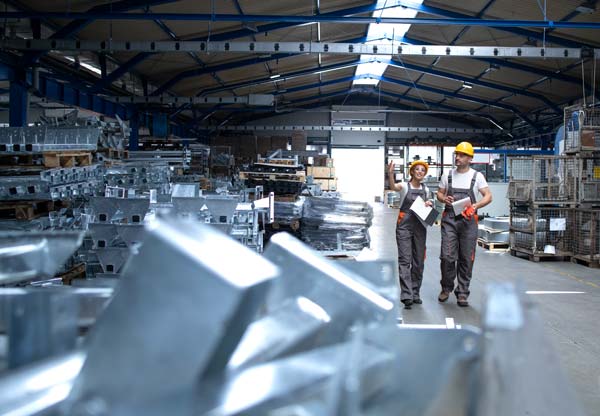The aluminium industry, a cornerstone of global manufacturing, faces significant challenges in balancing production efficiency, energy costs, and environmental compliance. From primary smelting to rolling and processing, every stage demands precision control and optimization. Programmable Logic Controllers (PLCs) and Distributed Control Systems (DCSs) serve as the backbone of industrial automation, playing a pivotal role in transforming aluminium production. By integrating advanced PLC and DCS technologies, aluminium producers can achieve intelligent operations, maximize energy efficiency, and drive sustainable practices. This article explores 15 key PLC and DCS solutions tailored for the aluminium industry, highlighting their impact on operational excellence and environmental responsibility.
1. Precise Electrolytic Cell Control
The Hall-Héroult process for aluminium smelting requires meticulous control of voltage, current, and alumina feed. PLCs enable real-time monitoring and adjustments to maintain stable cell conditions, reducing anode effects and energy waste. For instance, ABB’s System 800xA integrates PLCs to optimize potline performance, achieving up to 5% energy savings per ton of aluminium produced.
2. Energy Management Optimization
Smelting consumes 13-15 kWh per kg of aluminium, making energy efficiency critical. DCS platforms aggregate data from rectifiers, transformers, and potlines to balance loads and integrate renewable energy sources like hydro or solar. This reduces operational costs and carbon footprints, with systems like Siemens PCS 7 enabling dynamic energy allocation.
3. Electromagnetic Stirring Automation
PLC-controlled electromagnetic stirring enhances molten aluminium flow in furnaces, improving metallurgical quality. By automating stirring parameters, PLCs reduce energy consumption and ensure consistent casting quality, as seen in ABB’s solutions for smelter furnaces, which can lower energy use by 3-5%.
4. Fume Treatment and Emission Control
Aluminium smelters emit hydrogen fluoride (HF) and particulates, requiring robust gas treatment systems. DCSs integrate sensors and scrubbers to monitor emissions and recover fluoride for reuse, ensuring compliance with regulations like EU’s Industrial Emissions Directive. Rockwell Automation’s PlantPAx DCS offers seamless control for such processes.
5. Predictive Maintenance Systems
PLCs and DCSs leverage IoT and AI to monitor equipment health, such as potline rectifiers and anode baking furnaces. By predicting failures, these systems minimize downtime and extend asset life. For example, ABB Ability™ Predictive Maintenance reduces unplanned outages by up to 30% in smelters.
6. Automated Anode Management
Anode production and replacement are labor-intensive and critical for smelting efficiency. PLCs automate anode forming, baking, and positioning, improving consistency and reducing worker exposure to hazards. Automated systems in modern smelters, like those from Schneider Electric, enhance anode quality and cut costs.
7. Alumina Feeding Optimization
Precise alumina delivery to electrolytic cells prevents anode effects and boosts efficiency. DCS-controlled systems, such as Hyper Dense Phase Systems (HDPS), ensure uniform feeding, reducing waste. Emerson’s DeltaV DCS optimizes alumina distribution, improving cell stability.
8. Potline Amperage Upgrades
Increasing cell amperage enhances production capacity without expanding infrastructure. PLCs manage higher currents while maintaining thermal balance, supported by DCS oversight for safety. Technologies like AP36 cells, controlled via PLC/DCS integration, achieve 10-15% higher yields.
9. Digital Twin Implementation
Digital twins simulate smelter operations, enabling process optimization without production risks. DCS platforms collect real-time data, while PLCs execute control adjustments based on twin insights. ABB’s digital twin solutions improve potline efficiency by simulating operational scenarios.
10. Waste Heat Recovery Systems
Smelting generates significant waste heat, which PLC-controlled systems capture for power generation or material preheating. DCSs monitor heat recovery units, enhancing energy efficiency by 5-10%. Such systems are increasingly adopted in Chinese smelters for cost savings.
11. Carbon Anode Quality Control
High-quality anodes reduce consumption (approximately 415 kg per ton of aluminium). PLCs automate anode production processes, ensuring low impurities and optimal baking. DCSs provide oversight, with solutions like Honeywell Experion PKS improving anode consistency.
12. Safety Instrumented Systems (SIS)
Smelters require robust safety measures for high-voltage equipment and hazardous environments. PLC-based SIS ensure emergency shutdowns and fault protection, meeting SIL standards. Yokogawa’s ProSafe-RS integrates with DCS for comprehensive safety management.
13. Remote Monitoring and Control
DCS platforms enable remote oversight of smelter operations via SCADA integration, reducing on-site staffing needs. PLCs execute local control tasks, ensuring reliability. This is critical for remote smelters, with ABB’s 800xA offering centralized dashboards for global operations.
14. Integration with Renewable Energy
Transitioning to solar, wind, or hydropower reduces reliance on fossil fuels. DCSs manage grid integration and load balancing, while PLCs control power distribution to potlines. Smelters in regions like the Middle East benefit from Siemens’ solutions for solar integration.
15. Data Analytics and Traceability
PLCs and DCSs collect production data for analytics, enabling process optimization and quality traceability. Integrated with MES systems, they support Industry 4.0 initiatives. For example, Rockwell’s FactoryTalk Analytics improves decision-making in aluminium processing.
Implementation and Impact
These solutions can be tailored to specific smelter needs, from retrofitting older plants to designing greenfield facilities. PLCs excel in discrete control tasks like anode handling, while DCSs provide holistic oversight for complex processes like potline management. Combined, they reduce energy consumption by up to 10%, lower emissions, and enhance product quality. For instance, a modern smelter using ABB’s PLC/DCS integration can achieve near-zero anode effects, significantly cutting greenhouse gas output.
Sustainability and Future Trends
The aluminium industry is under pressure to decarbonize, with goals like net-zero emissions by 2050. PLC and DCS solutions support this by enabling carbon capture integration, inert anode trials, and renewable energy adoption. Emerging technologies, such as AI-driven process optimization and blockchain for supply chain transparency, are also being integrated into PLC/DCS frameworks, positioning aluminium producers for a sustainable future.







